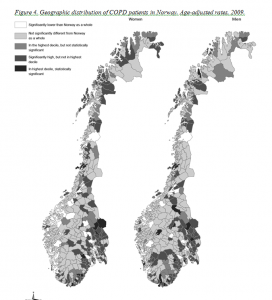The findings are thanks to researchers at SINTEF Technology. They have conducted one of the world’s first population studies into COPD by extracting and linking data from various national registers. These include registers held by Statistics Norway, the Norwegian Patient Register and the Norwegian Prescription Databases.
The rules governing the use of national registers have changed in Norway in recent years, and when the project on the causes and spread of COPD (Chronic Obstructive Pulmonary Disease) started in 2009, this gave us an ideal opportunity to extract data on the entire Norwegian population.
“Our focus has been on socio-economic causes and gender differences”, say Thomas Halvorsen and Pål Martinussen at SINTEF. “As far as we know, there have been many studies on COPD in other countries, but only on a regional scale – not on entire populations. Since we have now been able to make connections at an individual level, we can demonstrate that it is the inland parts of eastern Norway, as well as municipalities in southern Norway that have the most COPD patients. Women and men both follow the same geographic pattern”.
Many COPD patients not diagnosed
There is not much information about the exact number of Norwegians with COPD. The estimates show that there are between 200,000 and 300,000 people with the disease, but that the number whose diagnosis has been confirmed is much higher than that. It is possible to use the Norwegian Prescription Database to estimate how many are receiving medication for the disease. In 2009 it was around 67,000.
“There are a great many undiagnosed COPD patients”, says Halvorsen. “The first COPD symptoms are often mistaken for common infections or asthma, and many people put off going to see their doctor”.
Smoking not the only factor
Smoking has always been linked to COPD as its most obvious cause, but when the researchers compared the distribution of COPD patients in Norway with a map showing the distribution of Norwegian smokers, they saw that the two did not match.
“We found no clear concurrence between the two factors. We created maps for the 1996–2000 period, which show smokers at county level. It is apparent from these maps that most smokers are in Finnmark, with relatively few male smokers in eastern Norway, even though the incidence of COPD appears to be high there. This may mean that there are other significant causal factors”.
So the researchers obtained information about socio-economic factors at municipality level (income, civil status, employment status), and studied whether this information could be related to the risk of COPD.
“We saw that the lower the level of education in the population, the higher was the risk of COPD. Education and income are related to how you live/what you eat/whether you exercise, etc. In professions with a low level of education, you may be exposed to more smoking, and diet is also determined by socio-economic status to some degree”.
Access to fresh air?

Click to open
The researchers found that fewer people have COPD in municipalities dominated by agriculture and fisheries industries. For example, it is much less widespread in western Norway and the outer fjords. This is related to fresh air, and the fact that people in the primary industries are outside for longer. The life expectancy of people in these areas is also higher.
“We also know that there is more environmental pollution in inland eastern Norway than in western Norway, and this is also related to COPD”, says Halvorsen. The study concludes by saying that there are several risk factors. Smoking is still the most significant, but many other factors appear to play a role.
Women catching up
In line with other studies into age and COPD, we can see that men aged seventy and over have a higher risk than women, since the men as a group have been exposed to more cigarette smoke during their lives. But the gap between the genders is steadily decreasing, and in the population below seventy, women have begun to catch up with men.
The researchers believe that there is reason to believe that female COPD patients will become the majority in years to come. A number of studies also indicate that women can be more physically susceptible and therefore have a lower tolerance to cigarette smoke than men.

